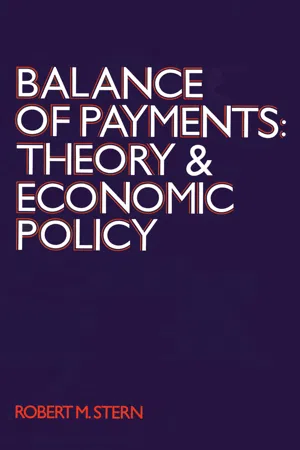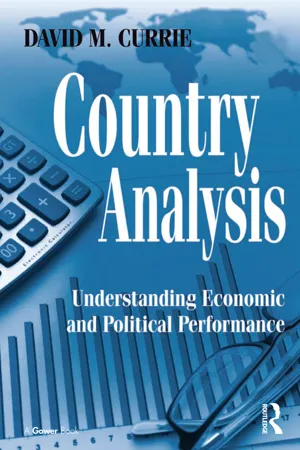Devaluation and Revaluation
Devaluation refers to a deliberate decrease in the value of a country's currency relative to other currencies, often to boost exports and economic growth. Revaluation, on the other hand, involves a deliberate increase in the value of a country's currency. Both devaluation and revaluation can have significant impacts on a country's trade balance, inflation, and overall economic competitiveness.
6 Key excerpts on "Devaluation and Revaluation"
- eBook - ePub
Development Economics
Theory and Practice
- Alain de Janvry, Elisabeth Sadoulet(Authors)
- 2021(Publication Date)
- Routledge(Publisher)
...Devaluation will induce changes in real balances, which are the opposite of those in Table 9.1. There are additional consequences of an exchange rate devaluation, as follows (Edwards, 1989). The price of tradable goods rises. This will induce domestic inflation, especially when tradables are an important component of the CPI. Inability to control inflation will lead to renewed appreciation of the currency and the need for future devaluations. While modest inflation may be good for growth, as prices need to reflect improvement in the quality of goods, more than modest inflation is detrimental to growth because of the uncertainty it creates on expected returns from investment. Inflation is, in addition, notably detrimental to the real incomes of the poor (Easterly and Fisher, 2001). Whether the economy will benefit or not from devaluation depends on: (1) whether increases in border prices are transmitted to producers of tradable goods, as opposed to being absorbed by intermediaries, and (2) whether producers have the capacity to respond to price incentives through higher levels of production. When producers are smallholder farmers and SMEs, the elasticity of supply response may be low, resulting in more inflation and less growth. Where FDI flows to tradable sectors, FDI should increase. Where it flows to non-tradable sectors, FDI should decrease. In China, many foreign enterprises have invested to service the domestic market with non-tradables such as national telecommunications. These enterprises will not be particularly interested in putting political pressure on China to appreciate/revalue its currency as it will decrease the demand for non-tradable goods...
- eBook - ePub
- Enrico Colombatto(Author)
- 2016(Publication Date)
- Routledge(Publisher)
...If the cost of inputs in country A stays constant, the rise in productivity will initially make A's goods relatively cheaper. A's buyers will thus turn to their domestic producers and B's buyers will try to import more from A. As a consequence, the demand for currency A (dollars) on the exchange-rate market increases, and its supply will decrease (see the dashed lines). Hence, the dollar will appreciate relative to the yen: in the figure the exchange rate moves from 104 yen per dollar to 120. Figure 9.3 The exchange rate and productivity 9.7 Competitive devaluations, capital movements and the strength of a currency The simple example above draws attention to three points, which we briefly mention in this section. First, note that there can be no ‘competitive depreciations’ under a flexible-exchange-rate regime. A competitive depreciation refers to a situation in which a central authority – usually the central bank – purposefully intervenes in order to weaken the exchange rate of its own currency A, and thus to lower the price of A's goods and services on international markets. Yet, since the very essence of a flexible-exchange-rate regime rules out all interventions by a central authority, depreciations can only be provoked by prior changes in other variables, as seen above. Just as in the case of deflation, therefore, depreciations under flexible-exchange rates are the consequence of changes in the real economy or of monetary profligacy. Of course, we do not deny that central banks do intervene on currency markets, e.g., by issuing new money and selling it directly on the exchange-rate market; or by using their foreign-currency reserves and buying their own currencies. When this happens, however, the exchange-rate regime is no longer ‘flexible’...
- eBook - ePub
Balance of Payments
Theory and Economic Policy
- Robert Stern(Author)
- 2017(Publication Date)
- Routledge(Publisher)
...Put differently, taking these latter conditions for granted, a successful devaluation necessarily implies a deterioration in the terms of trade. It is also possible to take interest-rate considerations into account in terms of the demand for money in the two countries. We shall refrain from doing so on a formal basis and instead shall indicate qualitatively how the results of the model would be affected. 9 We noted in Chapter 6 that the pegging of the rate of interest by maintaining an infinitely elastic supply of money and credit at the going rate was a standard feature of Keynesian models of national income determination. This kind of monetary policy, which Tsiang (1961; 1968, p. 401) has called “Keynesian neutral monetary policy,” may be acceptable in dealing with underemployment conditions. But it has drastic implications for exchange-rate stability once resources are literally fully employed. When this point is reached, the elasticity of supply of domestic output becomes zero, with the consequence that devaluation would have no effect whatever on the balance of trade. If we add to this the possibilities of market-power inflation with the approach to full employment and speculative capital movements in anticipation of a change in the exchange rate, the instability would be heightened. A policy of continuous monetary expansion under such conditions would thus be disastrous for exchange-rate stability. 10 In contrast, what Tsiang (1961; 1968, p. 401) called “orthodox neutral monetary policy” can play an important stabilizing role in the foreign exchange market. This will be because of the interest-rate variations that will occur when there is a devaluation and the money supply is kept unchanged. 11 What will happen then is that there will be a reduction in aggregate expenditure as the rate of interest rises with a devaluation at full employment insofar as individuals and firms strive to maintain the real value of their money-cash balances...
- eBook - ePub
- James P. Neelankavil, Anoop Rai(Authors)
- 2014(Publication Date)
- Routledge(Publisher)
...Foreign currency is available for spot (immediate) exchange or forward deliveries. Forward rates for many currencies are available for 30-, 60-, and 90-day deliveries. If a country has to pay more for a foreign currency, we consider the home currency to have depreciated or the foreign currency to have appreciated. When a home currency depreciates, goods in the home currency become cheaper because the foreign purchaser pays less to acquire the home currency. As a result, a depreciating currency will increase exports and reduce imports for the country. As exports continue to increase, ceteris paribus, there will be an increase in demand for the home currency, and eventually this will cause the rates to return to equilibrium. The main determinants for the demand and supply for a foreign currency are exports, imports, and the inflation and interest rate differentials between the countries. The higher the relative inflation rates or interest in a country, the more likely its currency will depreciate against the other currency. The major players in the foreign exchange markets are the major international banks, followed by nonbank brokers, central banks, and corporations and individuals. The bulk of the trading takes place between the major banks, defined as wholesale trades. Wholesale trades account for 85 percent of all foreign currency transactions. Finally, understanding foreign exchange markets is important for managers of multinational corporations. Managers need to be aware of the future direction of foreign exchange rates in order to price goods for overseas markets and source raw materials for production. Foreign exchange rates also affect pricing in domestic markets because procuring raw materials at cheaper rates enables companies to sell their output at competitive domestic rates...
- eBook - ePub
Country Analysis
Understanding Economic and Political Performance
- David M. Currie(Author)
- 2016(Publication Date)
- Routledge(Publisher)
...It all depends on how the exchange rate is quoted. All you have to do is make up a few examples using various prices, try exchange rates quoted in both directions, and practice them a few hundred times. Pretty soon it will become second nature. That’s the advantage that many foreigners have over us Americans – they exchange currencies constantly, most of us do it only occasionally. Appreciation and Depreciation Now let’s examine the other currency exchange: when we receive 1,000,000 euros from the Treasury of France in three months, we must sell those euros for dollars (another way of saying the same thing is that we must use the euros we receive to buy dollars). The difficulty is that we don’t know now what will be the value of the euro in three months. Currencies constantly change value as factors in the currency markets fluctuate. Political situations, economic indicators, balance of payments, and market psychology are never constant, and exchange rates reflect the fluctuation. We are exposed to currency risk or exchange risk : the risk that one currency will exchange for a different amount of another currency. When a currency increases in value, the currency is said to appreciate. Appreciation means the currency is worth more of another currency. If you own it, you can sell it for more of another currency. If you don’t own it and need to buy it, you’ll have to pay more for it than before it appreciated. It’s just the opposite with depreciation, which means that the currency is worth less of another currency. If you own it, you can’t sell it for as much of another currency. If you don’t own it, you can buy it at a lower price than previously...
- eBook - ePub
The Economics of Inflation
A Study of Currency Depreciation in Post-War Germany, 1914-1923
- Constantino Bresciani-Turroni, Millicent E. Sayers(Authors)
- 2013(Publication Date)
- Routledge(Publisher)
...Chapter VI The Depreciation of the Mark and Germany's Foreign Trade * I. Differences of Opinion between Economists about the Influence of the Paper Inflation on the Balance of Trade 1. The classical school was more concerned with determining the conditions of a given static equilibrium than with studying the period of transition between one static equilibrium and another. On the foreign trade of a country and monetary depreciation the statement of Stuart Mill is characteristic: "The imports and exports are determined by the metallic prices of things, not by the paper prices. . . a depreciation of the currency does not affect the foreign trade of the country: this is carried on precisely as if the currency maintained its value." † The effects of the currency depreciation on foreign trade subsequently formed an object of investigation by many economists; among those in the first rank Wagner must be mentioned. 2. In the opinions of writers there have appeared two diverse conceptions of the relations between paper circulation and the balance of trade. Goschen writes: ‡ "it will be easily seen why it is possible to assume that a country in which a depreciated currency and a prohibition to export bullion exist, is likely to be importing more than it is exporting. . . . Sometimes Governments, simply for their own purposes, issue a quantity of paper money: the natural consequence will be over-importation; prices will rise in consequence of the increase in circulation, and accordingly attract commodities from other markets, while the exports, having risen also, will be less easy of sale abroad." But this conception is contradicted by the fact that in countries experiencing a progressive depreciation of money, internal prices computed in gold were generally less than gold prices in the world market. But there is an alternative line of argument. The increase of note-issues influences the foreign exchanges before internal prices...





